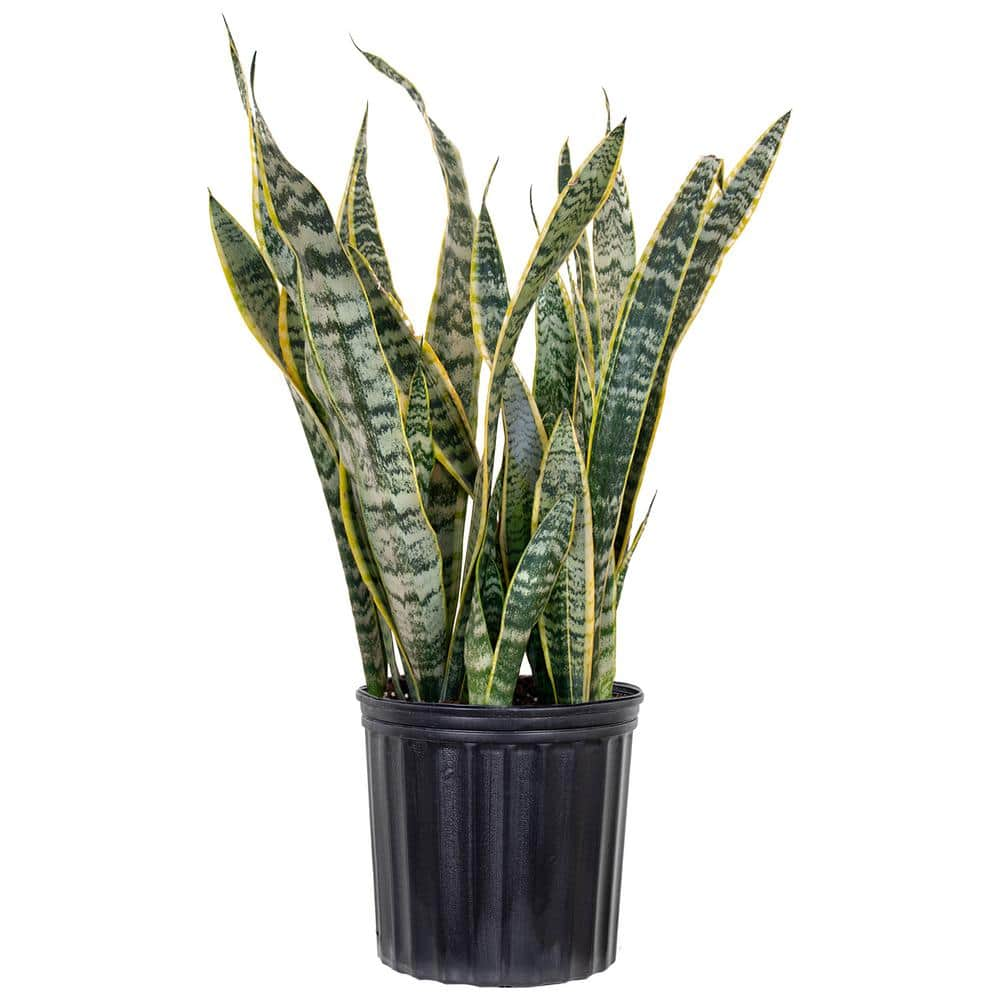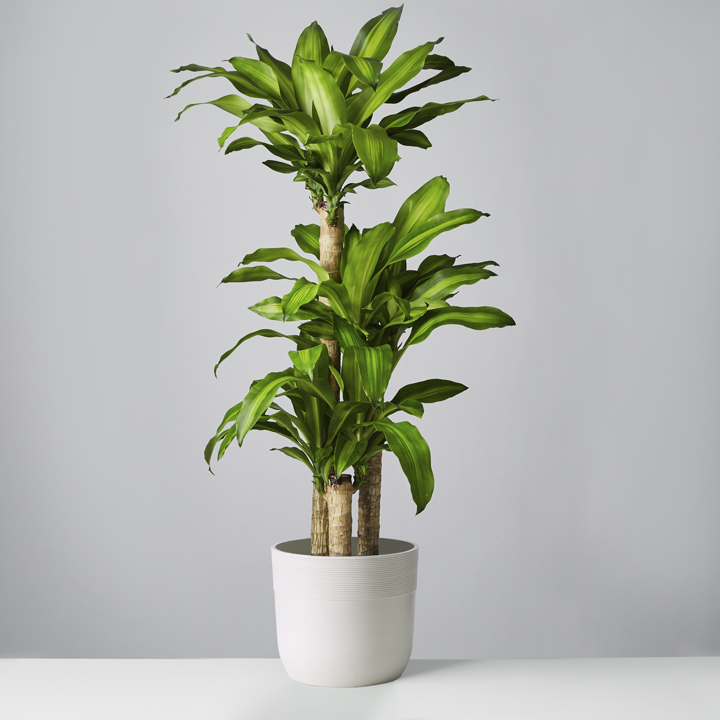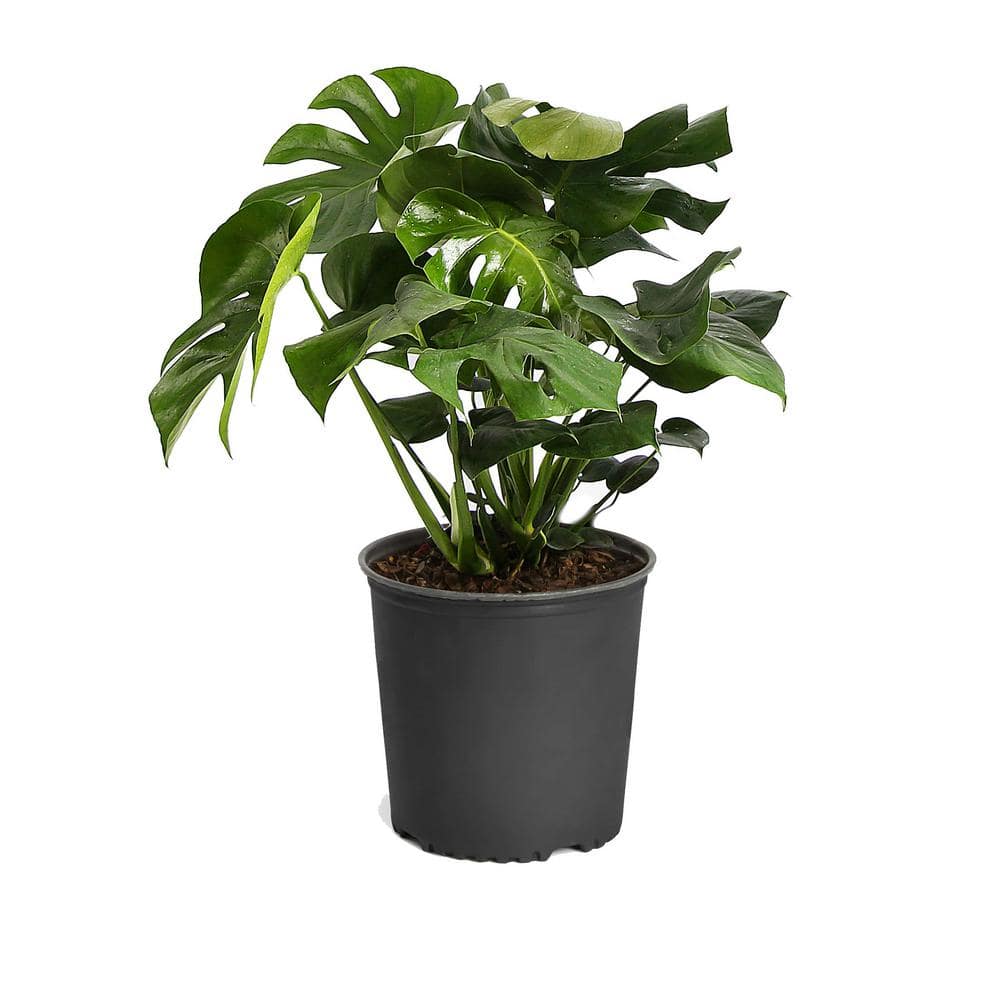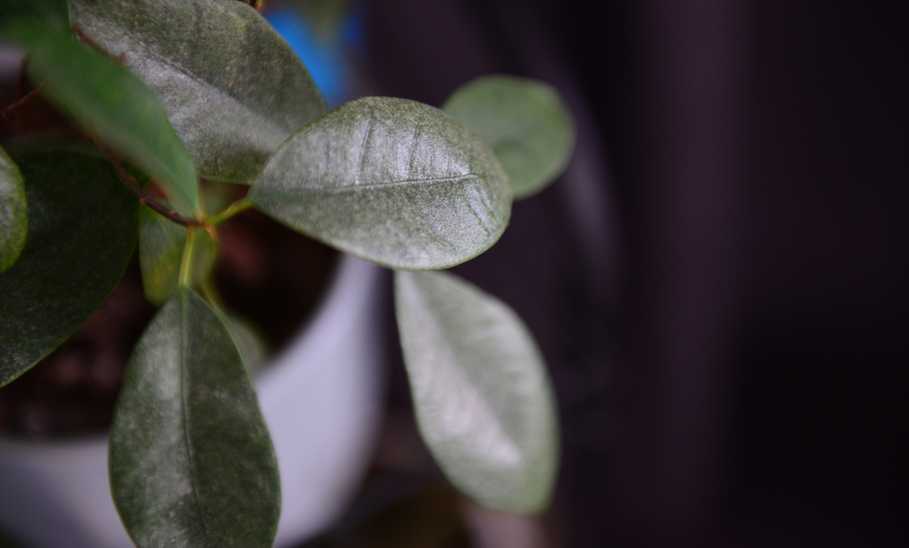Not every home has bright floor to ceiling windows, so a low-light plant can be an ideal solution for a not-so-sunny problem. All plants need some light to live, but low-light plants can even use artificial light to survive—and some plants, like ferns and vines, can survive in the dimmest part of homes. This means you can easily brighten up a dingy bathroom, add a floral pop to a windowless kitchen, or spruce up your workspace with a small plant even if your desk is in a dark corner. For more tips on choosing a great low-light plant for your indoor space, I consulted with Romina Orozco-Encio, owner of Abbott Florist in Miami Beach. Read on for what to consider before you shop.
Our top picks for best indoor plants for low light
Best low-light plant for small spaces: Lemon Button Fern
The Lemon Button Fern is a simple plant solution that’s pet-friendly and flexible enough to work in almost any environment, making it one of the best indoor plants for low light.
Set to only grow around a foot high, this plant is perfect for small spaces and requires only minimum maintenance. Native to places like Asia, Australia, and Florida, it makes for a wonderful pairing with many other tropical plants.
Specifications
- Size: This plant typically reaches 5-7 inches in height and 4 inches in width.
- Water: This plant likes to stay pretty wet and prefers water about once a week. Adding some mist every few days can also be beneficial.
- Light: 12-14 hours of light is recommended
- Sun exposure: Bright or indirect light, but can thrive in low and bright light environments
- Pet friendly: Yes
- Fertilizer: Liquid fertilizer diluted to half-strength applied on a schedule of once a month should help this plant to remain healthy.
- USDA hardiness zones: 10-11
- Soil condition/pH: 4-7
- Price: $16.99-$43
Pros:
- Looks beautiful
- Thrives in most environments
Cons:
- Price can be high depending on the retailer
- Optional Eco Pot from Lively Root looks nice but costs more
The bottom line:
With its simple beauty and easy maintenance, the Lemon Button Fern is a lovely indoor plant that’s perfect for small spaces.

Dracaena Janet Craig Compacta
The Dracaena Janet Craig Compacta is a fantastic option for tall indoor plants that need low light. Typically growing between six to eight feet, this plant is towering in its height and dignified in its look. If purchased from Easyplant, the self-watering system simplifies the maintenance process, helping your plant drink only when it’s thirsty. The Dracaena can also grow in partially shaded outdoor environments, and in some conditions, can grow up to 15 feet tall. For a long-living plant that is good for low-light, indoor environments, the Dracaena Janet Craig Compacta is an ideal one to consider.
Specifications
- Size: At mature growth, this plant is 5 feet tall and 3 feet wide.
- Water: This plant likes water every 10-14 days, but also benefits from misting in between.
- Light: 4-8 hours of light a day is ideal for this plant, but avoid too much direct light.
- Sun exposure: Thrives in bright indirect sunlight
- Pet friendly: No
- Fertilizer: This plant doesn’t require fertilizer but could benefit from changing the potting soil once a year.
- USDA hardiness zones: 9-11
- Soil condition/pH: 6-7
- Price: $44.74-$259
Pros:
- Impressive height
- Easyplant’s self-watering system makes maintenance easier
Cons:
- Price for larger plants can be prohibitive
- Too tall for some spaces
The bottom line:
If you’re looking for a tall, stately plant to bring color to a dark room, the Easyplant Dracaena Janet Craig Compacta is a great choice.

Costa Farms Fiddle Leaf Fig Tree, Ficus Lyrata Live Indoor Plant Potted in Indoor Garden Plant Pot
10% offSave $7
Orozco-Encio advises that the Fiddle Leaf Fig is a great option for low-light rooms—and is also very easy to care for. “This is a low-maintenance plant that doesn’t require too much watering and is easy to grow.” This offering from Costa Farms comes in a beautiful cream colored pot, and arrives at 3 to 4 feet in height, with the potential to grow up to ten feet tall. The lovely green leaves add a tropical splash of color to any lower-light room!
Specifications
- Size: 3-4 feet tall on delivery, can grow up to ten feet
- Water: Once a week
- Light: Steady, indirect light exposure, e.g. several feet away from a south-facing window
- Sun exposure: Indirect sun — place the plant a few feet back from the window
- Pet friendly: No
- Fertilizer: Fertilize every time you water during growing season; not in winter
- USDA hardiness zones: 9-11
- Soil condition/pH: 6-7
- Price: $72.99
Pros:
- Gorgeous cream colored pot
- Free shipping with Amazon Prime
- Easy to care for
The bottom line:
A beautiful indoor plant that’s easy to care for and thrives in lower light conditions.

Sansevieria Laurentii Indoor Snake Plant
The Snake Plant is a lovely plant that is air-purifying at night, filtering out both nitrogen oxide and formaldehyde while you sleep. This is a tropical plant in appearance but laid back in what it requires from you. If you’re searching for a plant that’s easy on the eyes and offers added benefits for the air, the Snake Plant is an excellent choice.
Specifications
- Size: At full maturity, this plant typically reaches 4-6 feet in height and 2 feet in width.
- Water: Allow soil to dry out and water this plant about every two weeks.
- Light: 8-10 hours of indirect light is ideal for this plant.
- Sun exposure: This flexible plant grows well in bright and very low light.
- Pet friendly: No
- Fertilizer: With half-diluted fertilizer, this plant thrives on a schedule of once in spring and once in mid-summer. Nothing is required in winter.
- USDA hardiness zones: 9B-11
- Soil condition/pH: 5.5-7.5
- Price: $25.98-$27.99
Pros:
- Reasonable price
- Air-purifying plant
Cons:
- Too tall for some applications
Best large plant for low light: Cat Palm

Cat Palm
To make an impact on your space, sometimes it takes a larger investment, and the Cat Palm is one of the best large plants available. Growing up to six feet tall and approximately three feet wide, this plant is tropical in its style and impressive in its appearance. The clusters of leaves are a gorgeous green, and if purchased from Easyplant, the simple self-watering system makes watering a breeze. This plant prefers bright indirect sunlight, but is also adaptable to medium- and low-light situations.
Specifications
- Size: This plant grows from 4-6 feet in height and up to 3 feet in width.
- Water: During spring through fall, water once a week. As temperature drops during winter months, watering once every other week is sufficient.
- Light: Prefers a few hours of direct sun but too much harsh sunlight can potentially damage leaves.
- Sun exposure: Grows best in bright and indirect light
- Pet friendly: Yes
- Fertilizer: Diluted, half-strength liquid fertilizer once a month in spring and summer during the plant’s growing season.
- USDA hardiness zones: 9-11
- Soil condition/pH: 5-7.5
- Price: $42.22-249
Pros:
- Gorgeous appearance
- Impressive self-watering pot (from Easyplant)
Cons:
- Price can be high depending on the retailer
The bottom line:
The Cat Palm fills your space with tropical vibes, and can survive in low-light areas.

Mass Cane Floor Plant
If you’re suffering from sinus issues, this plant can help clear the air. The Mass Cane Floor Plant has been shown to filter indoor pollutants from a room, it also adds vibrancy to your space. Also known as a corn plant, it boasts large stalk-like stems, and comes with six colorful planter options.
Specifications
- Size: 45-60 inches in height
- Water: Every one to two weeks
- Light: Around 3-6 hours of direct light a day; can be damaged by too much sun
- Sun exposure: Thrives in bright, indirect light but can handle low light levels.
- Pet friendly: Best to keep away from pets and kids
- Fertilizer: Once a year
- USDA hardiness zones: 10-12
- Soil condition/pH: 6-6.5
- Price: $99.99 (double), $119.99 (triple)
Pros:
- Large, impressive leaves
- Good at removing room toxins
The bottom line:
This plant is both visually impressive and also has huge health benefits, like its ability to remove toxins in the air.

Ruby Necklace Succulent Othona Capensis
Sometimes, even our bathrooms can use a little sprucing up. The Ruby Necklace succulent features a beautiful blend of purple and green colors that are striking. Its small size makes it a great gift and also versatile for many other indoor uses. With a height of only four inches, this little plant is perfect to pair with others or simply to help adorn an already small space. Being a succulent plant, means it has low-maintenance requirements, for water and otherwise.
Specifications
- Size: Up to 12 inches in height and 4-8 inches wide
- Water: Once around every 2 weeks, allow soil to dry during waterings. Use a finger to determine if soil is dry and ready for more.
- Light: Needs a few hours of light a day, preferably morning and gentle afternoon sun
- Sun exposure: Bright, indirect light is important to this plant's survival.
- Pet friendly: Yes
- Fertilizer: Does not require much fertilizer, but diluted mixture every few weeks can help accelerate new growth.
- USDA hardiness zones: 9-11
- Soil condition/pH: 6-6.5
- Price: $12.99
Pros:
- Gorgeous color
- Reasonable price
Cons:
- May be too small for some
The bottom line:
With beautiful vibrant colors, the Ruby Necklace succulent is excellent for brightening up your bathroom or any other small space in your home.
Best small indoor tree for low-light: Dragon Tree Plant

Dragon Tree Plant
Native to Madagascar, the bright and beautiful Dragon Tree packs a lot of color into a small size. Ideal for medium or shaded sun exposure, this low-maintenance plant can also thrive under a variety of light conditions.
Specifications
- Size: Will take several years to grow to 2-3 feet tall; max size indoors is about 6 feet
- Water: Once a week when young, up to twice a week as the plant matures. Allow soil to dry between waterings.
- Light: For ideal growth, this plant needs 6-8 hours of light a day
- Sun exposure: Plant thrives in moderate and indirect sunlight
- Pet friendly: No
- Fertilizer: Monthly during spring, summer, fall
- USDA hardiness zones: 9-12
- Soil condition/pH: 6.0-6.5
- Price: $43 (small)
Pros:
- Beautiful leaves
- Convenient size for tropical plant
- Easy to care for
The bottom line:
When looking for a small indoor tree that thrives in low light, the Dragon Tree is both beautiful and low-maintenance.
Best low-maintenance indoor plant for low light: Swiss Cheese Plant

Swiss Cheese Plant
The Swiss Cheese plant is a beautiful low-maintenance option great for any room in the house. With glossy, green foliage, this plant looks unique and will grow successfully almost anywhere. It only needs to be watered about once a week, and is quick to grow.
Specifications
- Size: At maturity, 3-5 feet in height, 1-3 feet in width
- Water: No more than once a week
- Light: Prefers 8-10 hours a day of light exposure
- Sun exposure: This plant thrives in bright and indirect sunlight, and can also tolerate low light situations.
- Pet friendly: No
- Fertilizer: Every two to four weeks during spring and summer, every two months in winter
- USDA hardiness zones: 10-12
- Soil condition/pH: 5.5-7.0
- Price: $47.21-$49.94
Pros:
- Lovely heart-shaped leaves
- Very low-maintenance
Cons:
- Though commonly listed as pet-safe, if eaten, it can cause symptoms like burning of the mouth and vomiting
- Shipping can cause potential damage
The bottom line:
The Swiss Cheese plant is instantly recognizable and thrives with minimal watering and attention.

Mounted Orchid: Phalaenopsis Violacea
The Phalaenopsis Orchid is a beautiful plant that thrives in low light, and while many varieties have no strong scent, the P. violacea is one that’s known for having a lovely sweet, spicy smell—some say they smell like roses and cinnamon. (It’s often used as a floral note in women’s perfumes.) This particular plant is sold on a wood mount, which means it will not be blooming on arrival—but when it does, the bloom should be worth the wait.
Specifications
- Size: Can reach a height of 19 inches
- Water: Must be watered every 7 to 10 days
- Light: Prefers 11 hours of artificial light a day in winter, and 14 to 16 hours a day in summer
- Sun exposure: Indirect sunlight is necessary. Be warned that direct sunlight could potentially cause your plant to become sunburned.
- Pet friendly: Yes
- Fertilizer: Every other week or at least once a month following blooms
- USDA hardiness zones: 10-12
- Soil condition/pH: 5-6
- Price: $19.99
Pros:
- Gorgeous purple color
- Sweet, spicy scent
Cons:
- Blooms have a short lifespan
- Does not arrive in bloom
The bottom line:
It’s tough to find a low-light plant with a strong floral scent, but the Phalaenopsis violacea has you covered on both fronts.
Best indoor plant for dark rooms: ZZ Plant

ZZ Plant
The ZZ Plant is the absolute best for dark rooms, bright rooms, and everything in between. Known for its resilience, the ZZ plant is adaptable to almost any environment, even ones without natural light. For those that are forgetful, this is a very low-maintenance plant that still looks amazing. If purchased from Easyplant, their self-watering system allows up to two months between waterings. The tolerance and impressive appearance of this plant make it popular everywhere.
Specifications
- Size: 25-30 inches tall including pot; max height of about 3 feet
- Water: Every 2-3 weeks
- Light: Minimum of 6 hours per day; can tolerate up to 12 hours per day
- Sun exposure: Doesn’t tolerate direct sunlight; ideal for low light environments
- Pet friendly: No
- Fertilizer: Monthly during growing season
- USDA hardiness zones: 9b-11
- Soil condition/pH: 6-7
- Price: $39.02-$189
Pros:
- Ability to adapt to different environments
- Thick green leaves
The bottom line:
Flexibility can be everything and the ZZ Plant’s ability to function in dark rooms as well as bright ones makes it an easy choice for any space.
How I selected the best indoor plants for low light
Caring for plants is an art as well as a science, so I conducted research, spoke to experts, read user reviews, and also used my own experience shopping and caring for plants. In assessing the plants on this list, I considered three main factors.
Light conditions
If the plant requires bright, direct sunlight, it won’t be a good fit for darker or shadier spaces! In order to make the cut for this list, I selected plants that are listed as thriving under a range of lower light conditions: in indirect sunlight, in the shade, or even in artificial light. I also cross-checked the information listed on websites, with information received by experts, to ensure I selected plants recommended for lower light environments.
Size and shape
This is a list of the best indoor plants—and that means size matters. When selecting the plants to include on this list, I considered the current size and shape of the plant as well as the likelihood of expansion. I also sought expert advice on how to select plants for specific rooms in the house, based on light conditions, size, and shape of the grown plant.
Ease of care
Most of us don’t have the time or energy to spend all day catering to our houseplants, so I also considered ease of care. While some plants, like orchids, will require a higher skill level to properly care for, most of the plants on this list are relatively low-maintenance, requiring moderate watering and lower light.
What to consider when buying indoor plants for low light
Sunshine in your space
All low-light plants are not created equal. Some enjoy moderate sunshine, while others do best in shadows or even in a windowless room. Orozco-Encio says, “just because it’s an indoor plant, you can’t assume that means it’s ultra low light or that it wants sunlight. Some indoor plants need extremely low light while others will be happy in front of the window.”
For best results, Orozco-Encio suggests carefully considering the specific amount of sunlight that’s recommended for your plant, and placing it accordingly. “If you touch the window and you feel it’s warm, the sun is giving direct sunlight to the plant. So you need to make sure when you bring a plant home, look for the spot beforehand, and choose a spot that’s going to have the right sunlight level for that plant.”
Size and shape
When placing a plant in an indoor location, consider the current size of the plant and the size and shape you expect it to grow into over time. Orozco-Encio advises, “Some plants may grow in height, while others will tend to grow out to the side. So before choosing a spot for your plant, think about what shape it’s likely to grow into. If it’s going to have leaves growing out instead of up, it will need a lot of space around it.”
Humidity:
Plants are affected by more than just sunlight — they also respond to temperature and heat. Orozco-Encio says, “For some plants, you need a lot of humidity in the room. So even though the plant may do well with low light, it still may need a warmer space to thrive.” Check the instructions on the plant, or search for directions for that specific plant to learn more about the conditions it requires.
How to water and maintain indoor plants for low light
In low-light environments, plants tend to need less water overall. So, overwatering is something to watch out for, and if your plant begins to turn from green to yellow, it’s a possible warning sign that signifies you may need to pull back on the amount of water you’re providing. However, each plant has individual needs, so according to Orozco-Encio, “always check the water and care instructions for your specific plant to gain insight into how best to maintain it.”
Troubleshooting tips
When a plant's leaves start turning yellow, that often spells trouble. According to Orozco-Encio, “If it’s turning yellow, it’s a sign that the plant either is experiencing too much direct sunlight, or too much water. That’s a sign from the leaves that’s telling you, ‘Take care of me! You’re doing something incorrectly.’” For yellowing leaves, she recommends reducing the water or the sunlight, depending on what you think the culprit may be, and then keeping an eye on the plant to see how it responds.
Another important consideration is your soil type. Orozco-Encio says, “Make sure you know whether it’s a flowering plant or a green plant, because that will make a difference in terms of not just the care, but the soil. When it’s a flowering plant, it requires different soil, one with more nutrients, for the plant to flower.”
Frequently asked questions (FAQs)
What indoor plants like dark rooms?
According to Orozco-Encio, the Fiddle Leaf Fig is a popular low-light choice. “The fiddle leaf fig is very low-maintenance, and it has beautiful large green leaves. I call this one ‘the queen of the plants,’ because they don’t like it when you have too many other plants around. They grow best when they’re standing alone, not clustered with other plants. It’s low-light, low-watering, and easy to take care of. Never, never direct sunlight. The leaves get burned very quickly.”
What houseplants do well in shade?
According to Orozco-Encio, the Phalaenopsis orchid is a beautiful flowering plant that does well in low light and shade. “They come in various colors from white, to purple, lavender, yellow, and more. The flower itself lasts two to three months, but the plant can last forever. When the bloom dies, continue watering it, and maybe twice a year it will bloom again. This is an indoor plant, no direct sunlight, and very easy to take care of. You can water it every ten days, and we recommend spray bottle watering versus pouring water in, because it doesn’t drink a lot of water.”
Which plants do not require sunlight?
Romina says the Zamioculcas zamirola—often nicknamed the “ZZ” plant, is one that does well in very low light conditions. “This is a beautiful plant, and this plant is also very low light. Doesn’t matter if it has humidity or not. You only have to water it once a week, so it’s very low-maintenance, and it’s a plant that’s rich and shiny.”
What's the easiest indoor plant to grow?
Orozco-Encio recommends succulents as a low-maintenance plant for shady indoor rooms. “These are some of my favorites because they’re little, they’re tiny, they do well in low light, and they’re perfect for small spaces, or rooms like a bathroom or office. Succulents are from the cactus family. They are usually from two to eight inches. This kind of plant is very grateful. They are super low-maintenance. The less you do to them, the happier they are. So you can water them about every two weeks, some customers go 20 days without watering and they still look perfect. So if you travel a lot, this is the perfect plant for you because you don’t have to take care of it or pamper it too much.”
















